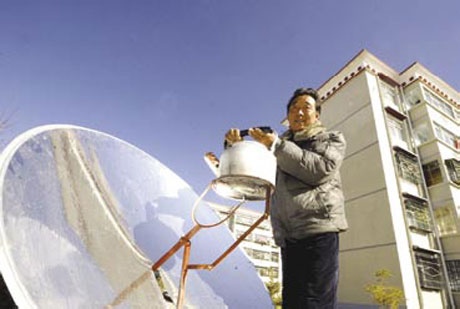China
Mountain sunshine brightens outlook for solar power sector
By Zhong Nan (China Daily)
Updated: 2010-10-08 07:58
 |
Large Medium Small |
|
 A resident in Lhasa, the Tibet autonomous region, uses solar energy to heat water. Xinhua |
Beijing - For the past 12 years, Kekyi Drolkar, 23, and her family, have been using solar cookers, kettles and water heaters at home in Lhasa in the Tibet autonomous region.
"The sun is really strong during the daytime, especially in winter," said Drolkar, who works for the Bank of China.
"It is convenient and costs nothing to use."
Her home's energy bill is also about half that of her neighbors. Her power bill averages about 40 yuan ($5.97) a month, compared with about 100 yuan for neighbors who don't use any solar-powered devices.
Indeed, half a million Tibet residents, or 17.2 percent of the population, use solar energy, thanks to the autonomous region's geographic advantage and government's incentives.
And the Xinhua News Agency reports that solar energy will account for 12 percent of all power generated in the region in 2020, up from 7 percent this year, with the percentage much higher in rural areas.
"Solar power will account for 60 percent of power supplies in Tibet's vast rural areas in 2015," Zhang Yongze, director of the bureau of environmental protection of Tibet, told Xinhua.
Dubbed as the roof of the world, Tibet has an average altitude of 4,900 meters and 3,400 hours of sunshine a year, compared with the 2,000-hour national average.
Since the 1980s, the local government has encouraged the use of solar energy applications, including solar thermal and photovoltaic power generation.
About 400 small- and medium-sized off-grid photovoltaic power stations have been built at different places in Tibet, each capable of producing between 10 to 130 kW of electricity.
Ma Shengjie, director of the department of science and technology of Tibet, told Tibet.news.cn that the total annual capacity of all photoelectric facilities in Tibet exceeds 9 mW, which saves burning more than 160,000 tons of coal each year.
Wang Haijiang, deputy director of the Energy Research and Demonstration Center in Lhasa, said photovoltaic power generation will play a crucial and long-term role in the region's energy development strategy.
He said solar energy has been used widely in areas such as water supply, households, communications, broadcasting, lighting and the military.
"More than 330,000 solar cookers and 400,000 square meters of polycrystalline silicon solar panels are being used in Tibet," said Wang, whose Lhasa-based institute carries out research into solar energy.
"But the solar water heaters in pastoral and agricultural areas haven't been commonly used because more water pipes have to be laid first."
However, the high prices of solar products may be affecting their popularity in this impoverished region.
A normal solar kettle costs between 200 and 300 yuan and a solar-powered water heater sells for between 2,800 and 3,500 yuan.
Last year, urban residents of Tibet earned an average annual income of 13,544 yuan while rural residents earned 3,531 yuan.